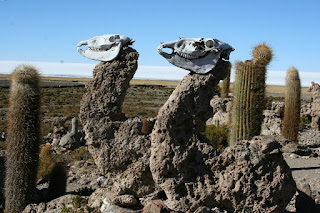 |
| Farewell salt hotel |
Our first stop this morning was at the nearby museum, which had an adjoining collection of petrified corals, studiously arranged and assembled to look like various animals.
 |
| Some cheating going on here |
After this slightly odd diversion, it was back into the jeep and out onto pristine white of the salt flats, past a group of tan and tame vicuñas.
 |
| Tunupa volcano |
Legend has it that the Tunupa volcano, at the foot of which we spent last night, is the representation of a beautiful woman. She was pregnant, but lost the child, the blood of which created the red lagoon we saw two days ago, while her milk went to make the salt flats.
 |
| Patterns in the salt made by aliens |
The endless, featureless landscape gives the opportunity for plenty of trick photography, in which the rules of perspective can be used to miniaturise one or other person standing distant from the camera. We spent the best part of an hour playing around with different combinations, while our guide good-naturedly took a series of photographs.
 |
| Tunupa volcano viewed from Incahuasi |
Of course, the unending whiteness isn't entirely featureless and is broken up by the coral islands. Incahuasi island is, like the others, covered in cacti and offers a grand view over the parched plains from the top. Among the rocks, we saw a tiny viscacha hopping like a miniature kangaroo.
 |
| Incahuasi island |
 |
| Les fous |
The salt flats attract other sports enthusiasts, and the area is annually host to the Dakar rally. However, in a recent event, many of the competitors got completely lost and had to abandon the race. Without features by which to navigate, I can appreciate how this might easily happen.
 |
| Dakar |
In a repeat of yesterday's impromptu 'lunch in the middle of nowhere', we parked up in the centre of the salar and set up the picnic tables and chairs.
 |
| Unobstructed view |
Despite the obvious popularity of the flats - judging by the number of tours operated from San Pedro and Uyuni - the landscape had swallowed all visitors and we were undisturbed for the entire course of our meal, which was accompanied by a bottle of perfectly good Bolivian red wine.
After lunch, we exited the flats by way of Colchani. At the edge, the salt is softer owing to a greater presence of water, and the local people heap the salt into piles to dry before taking it home for processing. The salt is iodised for consumption, as it was originally eaten in its natural state but caused sickness.
 |
| Salt mounds |
As with many industries we saw in Vietnam, the processing is done entirely within people's houses on a small scale. A factory was built, but now stands empty and derelict. Nobody could countenance leaving their family to work for someone else, when they could do the same thing under their own roof, earn their own money, and look after their children at the same time. I applaud such a refreshing attitude.
 |
| Working from home |
Our journey across the salt flats of Uyuni ended 30km outside of the town that gives its name to it, on top of a hill. The Luna Salada is another, significantly grander salt-based construction.
The hotel is enormous, its walls and much of the furniture made from salt bricks. Cosy nooks with fireplaces line the corridors and salt covers the ground and was even in our bedroom, which of course has a salt bed.
 |
| Salty carpet |
Isolated and essentially captive, we were at the mercy of the hotel dinner. This was a buffet, which often spells disaster for vegetarians. However, the chef personally presented a range of tasty dishes, from mushroom soup, to gratinated aubergine and other vegetables, salted marrow, and fried cabbage with rice. Dessert was a rather marvellous boozy pineapple affair.
No comments:
Post a Comment